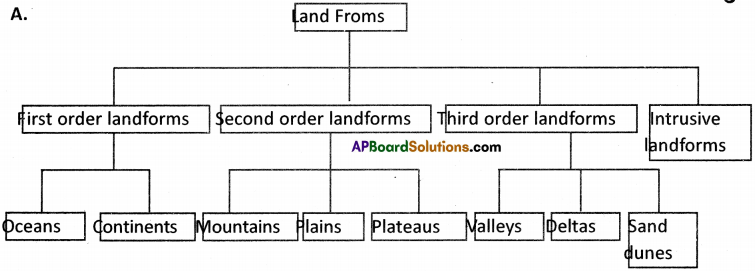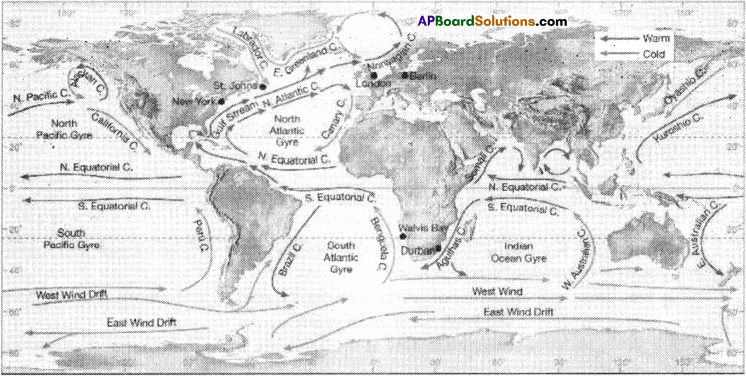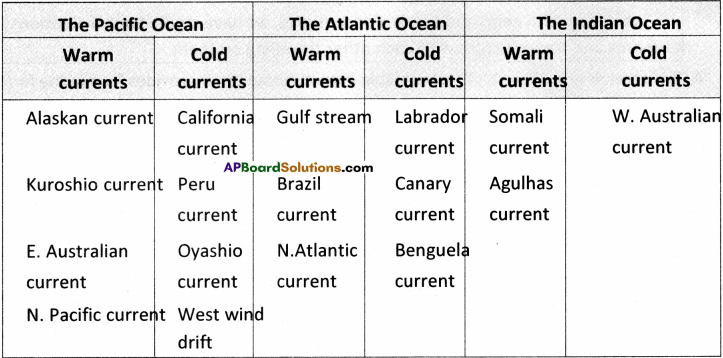SCERT AP Board 9th Class Social Solutions 3rd Lesson Hydrosphere Textbook Questions and Answers.
AP State Syllabus 9th Class Social Studies Solutions 3rd Lesson Hydrosphere
9th Class Social Studies 3rd Lesson Hydrosphere Textbook Questions and Answers
Improve Your Learning
Question 1.
Find the odd one out and give an explanation for your choice.
i) a) evaporation
b) condensation
c) salination
d) precipitation
Answer:
Odd one – (c)
Except salination, remaining all belong to the water cycle.
ii) a) tectonics
b) centrifugal force
c) solar energy
d) precipitation
Answer:
a) Tectonics is odd one : Remaining all are the factors that cause ocean currents.
![]()
Question 2.
Correct the false statements.
a) Oceans trenches can be located near the continents.
b) Relief features of the oceans are like plains.
c) Most salt in the seas is washed into it from the land over centuries.
d) Temperature of ocean water remains the same across the globe.
Answer:
a) Ocean trenches are the deepest parts of the ocean floor.
b) Relief features of the oceans are Trenches, Deep sea plains and Ridges.
c) True.
d) Temperature of ocean water varies from place to place across the globe.
Question 3.
Describe any one impact of ocean currents for the region you live.
Answer:
The Indian Monsoon current refers to the seasonally varying ocean current regime found in the tropical regions of the northern Indian ocean. The seasonally reversing open ocean currents that pass through south of India are referred to as the winter monsoon current and the summer monsoon current, alternately the north-east monsoon current and the southwest monsoon current.
India receives rainfall due to these currents.
Question 4.
Do you think that the description of blue planet is accurate? Describe any one way in which your activity impacts its oceans.
Answer:
Yes, I do think that the description of blue planet is accurate.
Humans are a part of the natural environment. But our activities lead to degradation of environment.
Oceans are suffering from our activities too, our land practices cause agricultural runoff, sewage, and litter to end up in the oceans daily. Today oceans have also fallen victim to our exploitation. Many large fishes like whales have been disappearing. Damage to oceans is damage to our livelihoods, well-being and nourishment.
![]()
Question 5.
Why differences are there in the salinity of oceans?
Answer:
- Salinity of ocean water depends upon many causes, but the main cause is continuous movement of ocean. Water from one place to other due to rotation of earth and winds which takes water here and there causing change in salinity of ocean water (ocean currents and thermohaline currents)
- Melting of ice causes an influx of fresh water, which dilutes ocean water.
- inflow of river water causes an influx of fresh water, which dilutes ocean water.
- Evaporation is only fresh water, which removes fresh water flow an area, causing salt to become more concentrated.
- Rain and snowfall opposite of evaporation, we are adding fresh water and diluting it.
- Wave and wind – various local mixing causes smaller – scale variation in surface salinity.
Question 6.
How is human life dependent upon oceans?
(OR)
How is human life depends on Oceans?
(OR)
How are oceans influencing human life?
Answer:
- Oceans stabilize climates over land.
- They are the storehouses of many chemicals, each of which are useful to humans.
- They disperse many plant & animal species from one continent to another, making biota available in various places. Many of these plants & animals are used as food, neutraceutically as medicines.
- Some people constantly live on boat, due to paucity of land in such areas.
- They are a source of various types of poly-metallic nodules.
- They are used for landing of certain debris of satellites & safely pad most of the meteors that come from outer space, as oceans cover more than 75% of earth’s surface.
Question 7.
Observe the map 1 on page 35 and write down the names of a few warm and cold currents.
Answer:
Some warm and cold currents :
- Equatorial current (warm)
- Gulf stream (warm)
- Labrador current (cool)
- Greenland current (cool)
- North Pacific current (warm)
- West wind drift (cool)
- East wind drift (cool)
- Bengula current (warm/cool)
![]()
Question 8.
Read the para ‘Ocean as a Resource’ on page 33 and comment on it.
Ocean as a ResourceMost life on earth is under the water. Human beings still have not finished identifying all the different forms of life in the oceans. Human beings have depended on oceans for their food and livelihood from the ancient times. Oceans provided abundant food resources like fish and salt. We also use the sand, gravel, etc. for our industries or housing. Humans extract minerals like chlorine, fluroine, iodine from it. Ocean waves are used for generating power. Ocean floor is mined for oils. Oceans also provide us with gems and pearls. For centuries, we have created our civilisations on its shores and traded across with each other travelling on them.
Answer:
The ocean is one of earth’s most valuable natural resources. It provides food in the form of fish and shell fish. It is used for transportation – both travelling and shipping. It provides a treasured source of recreation for humans. It is mined for minerals and drilled for crude oil.
Question 9.
Prepare a flow chart which shows different land forms.
Answer:


Question 10.
Prepare a list of currents which are found in the Pacific, Atlantic and Indian oceans. Identify the cold and warm currents in different oceans.
Answer:


9th Class Social Studies 3rd Lesson Hydrosphere InText Questions and Answers
Question 1.
Give the reasons for the Sow salinity of Baltic sea. (Text Book Page No. 32)
Answer:
- Baltic sea is a brackish mediterranean sea located between Central and Northern Europe.
- The Baltic sea’s salinity is much lower than that of ocean water.
- Baltic is a small sea on a global scale.
- The causes for the low salinity of the Baltic sea are
a) The abundant fresh water run off from the surrounding land.
b) The shallowness of the sea.
c) The flow of fresh water into the sea from approximately two hundred rivers and the introduction of salt from the south builds up a gradient of salinity in the Baltic sea.
d) The Baltic sea is only connected to the world’s oceans by the narrow and shallow waters of the Sound and Belt-sea.
e) This limits the exchange of water with the North sea and means that the same water remains in the Baltic for a lot of years.
For all the above reasons the salinity of the Baltic sea is less than that of the salinity of the oceans.